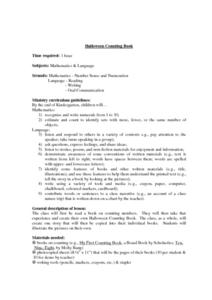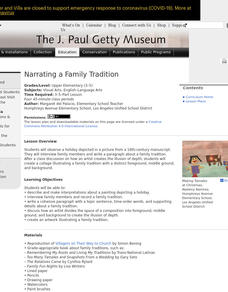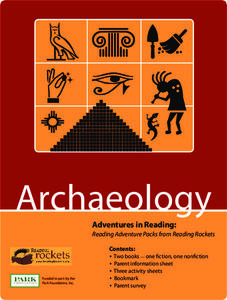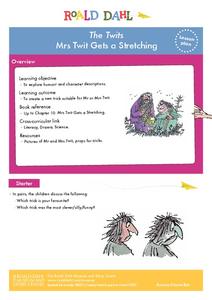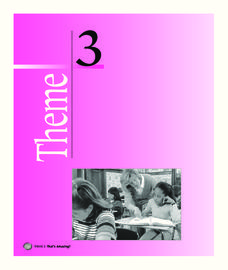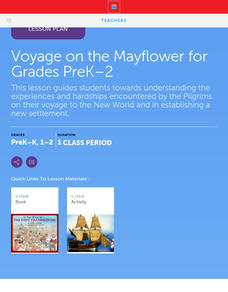Curated OER
Creating a How To Book
Third graders investigate "How To" books by watching a "How To" video and looking at books in the media center. They make a class "How To" book with a title page, table of contents, individual student pages, and graphics which they make...
Curated OER
Writing Mathematical Equations
In this algebraic equations worksheet, 7th graders write an algebraic equation with one variable for each problem. Students then solve the problem.
Curated OER
Halloween Counting Book
First graders recognize and write numerals from 1 to 10. They estimate and count to identify sets with more, fewer, or the same number of objects, listen and respond to others in a variety of contexts, and take turns speaking in a...
National Book Network
A Day with No Crayons
Colors and crayons are the inspiration for this collection of activities! Kids illustrate the real world, come up with their own names for colors, make their own crayons (with teacher assistance), create artwork they can eat, and more.
This Reading Mama
Compound Word Pack
Class + room = classroom! And your class + this compound word game = fun and learning! Kids match cards that include words and sometimes images to create compound words.
J. Paul Getty Trust
Narrating a Family Tradition
After examining a piece of art, scholars discuss what they see, paying close attention to details and space. A read-aloud introduces the topic of family traditions. Pupils interview their family members about a tradition in preparation...
Houghton Mifflin Harcourt
Let’s Count!: Challenge Activities (Theme 5)
Challenge young scholars with a counting-themed series of activities. Your counters will write invitations to a feast, create books about dinner parties and animals, design posters, draw pictures of their favorite peaceful places,...
Novelinks
Wildwood Dancing: Vocabulary Squares
As part of a study of Juliet Marillier's Wildwood Dancing, class members create vocabulary squares for words drawn from the story.
PBS
Reading Adventure Pack: Archaeology
Readings of fiction and nonfiction texts followed by a series of activities put scholars in an archaeologist's shoes. Learners read two texts, Archaeologists Dig for Clues by Kate Duke and The Shipwrecked Sailor: An Egyptian Tale with...
Curated OER
The Grapes of Wrath: KWHL Strategy
Before beginning The Grapes of Wrath, readers create a KWHL chart recording what they already know about the Dust Bowl, the author, and the book, what they want to know, and where they might find answers to these questions. After reading...
Novelinks
Tuck Everlasting: Similes, Metaphors, and Personification in Imagery
Poetic language is abundant in Natalie Babbitt's beautiful novel, Tuck Everlasting. Learners note the examples of similes, metaphors, and personification they find as they read, and illustrate how the language creates a sensory...
Roald Dahl
The Twits - Mrs Twit Gets a Stretching
A cork, a rubber snake, and a bucket of mud may not seem like the best materials for washing a car, but they are in The Twits. The fifth lesson in an 11-part unit designed to accompany The Twits by Roald Dahl has readers role play...
August House
Anansi And Turtle Go To Dinner
That tricky Anansi! Join him and Turtle in the story Anansi and Turtle Go to Dinner by Bobby and Sherry Norfolk, based on the African folktale. Kids answer comprehension questions and sing songs about spiders before creating spider...
National Park Service
Who Grows There?
More than 127 non-native species live in Glacier National Park in Montana and their infestations are growing! Pupils read about and gather samples of exotic plants. Participants create a master book of pressed plants and complete a...
Houghton Mifflin Harcourt
That’s Amazing!: English Language Development Lessons (Theme 3)
That's Amazing! is the theme of an English language development unit created by Houghton Mifflin. Following a speak, look, move, and listen routine, scholars delve into topics; seasons, weather, animals, landforms, telling...
How Does She
I'm a Summer Reading Star!
Reading is rewarding on its own, but why not add in some extra incentives? As individuals read, they can fill out the bingo board included here, earn coupons, create bookmarks, and fill out a banner, piece by piece.
PBS
Copyright and Fair Use
When is using someone else's copyrighted material appropriate? Learn about copyright and fair use with a lesson from PBS.org. Scholars read through a reference sheet about authors' rights and users' rights, and then create posters...
Scholastic
Voyage on the Mayflower
After completing an online activity about the Mayflower, scholars draw a picture about what they know of the Thanksgiving holiday, including a one-sentence summary. A reading of If You Were at the First Thanksgiving by Anne Kamma is...
Curated OER
Making Cranberry Bread
While the preparation for this lesson is extensive, the results are well worth the effort. Prior to the lesson, Xerox the pictures from Cranberry Thanksgiving by Wende and Harry Devlin, collect the ingredients for Cranberry Bread, and...
Curated OER
Celebrate Writing!
Help your students celebrate their writing through publishing projects.
Curated OER
How-To Books
Students apply their knowledge and create a how-to book of their own. In this early childhood language arts worksheet, students learn about non-fiction books and write their own procedural non-fiction booklets.
Curated OER
NYC From A to Z
Second graders create an ABC book about New York City. In this ABC book lesson, 2nd graders find places of interest in New York City from A-Z. Students will research their place of interest. Students create maps and write an...
Curated OER
How Animals Bond
In this animals lesson plan, students students write a description about a pet or animal that they know. They include details that would help someone who has never met their animal feel like they know it already. Artwork about their...
Curated OER
Blue Moon
Students explore information about the moon. For this trans-disciplinary lesson, students first listen to a picture book about the moon, then create an accompanying art project to illustrate a blue moon. Finally, the students write facts...


